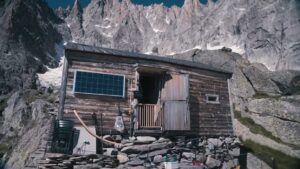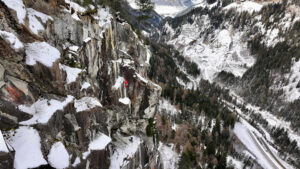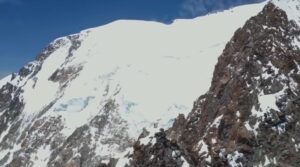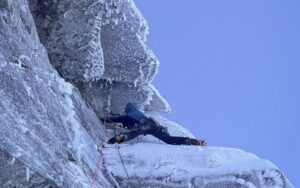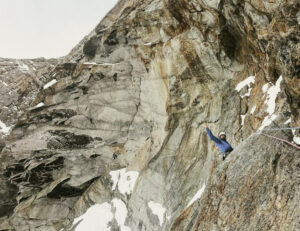In January of 2020, alpinist Dani Arnold headed for a challenge unlike any he’d faced before. The mountain athlete’s reputation had plenty of purchase in mountaineering circles, but the horizontal plane was a world unfamiliar.
This film from Mammut follows the affable Arnold and his partner, Martin Echser, to the heart of Siberia, to the deepest lake on the planet. His objective? Seeking out virgin climbing routes on the lake’s Olkhon Island.

Frozen Lake Baikal near Olkhon Island. Photo: Sergey Pesterev/Wiki Commons
Lake Baikal
Lake Baikal is a UNESCO World Natural Heritage Site, and experts estimate that it dates back more than 25 million years. At its deepest point, the freshwater lake measures 1,642 metres. By volume, it contains more water than any other freshwater body — just over 23,000 cubic kilometres.
Its remote location, coupled with the remarkably cold clime and jutting islands, made Lake Baikal an unlikely but prime candidate site for vertical discovery. During the winter, temperatures run as low as -40° Celsius.

Photo: Mammut
Decrypting Siberian ice
The Siberian winter provided fascinating conditions for this extraordinary trip, involving Arnold, Escher, Arnold’s father, and a diminutive film crew.
Due to the unadulterated nature of the Siberian tundra — particularly with regard to climbing — Arnold had perhaps more orienteering challenges than he’d initially imagined.
“It was very difficult to find helpful information,” he wrote. “Since certainly only very few ice climbers or even none, have been there before…Siberia is not exactly tiny. On departure, everything was still unclear, we did not know if we could even hit the ice machines somewhere. But there was also hope because there had to be something there.
“In a country where summer is only three months old and the lowest temperatures in the world are measured. We tried our luck on Lake Baikal. There we knew at least that the whole lake was frozen with a thick layer of ice.”

Photo: Mammut
Traveling across the ice via hovercraft by day was a mainstay for their expedition:
“The trip with the hovercraft was something new for all of us…This vehicle was powered by a large propeller and was usually very loud and not exactly fuel-efficient. One liter for one kilometre. The first steps on the lake or rather on the clear ice will remain in our memories for a long time. The perfectly clear layer of about 40-80cm of ice was already solid. Nevertheless, we were reluctant to move away from the safety boat. The knowledge that we are on the deepest lake on earth was of course also present in our minds.
“We took the hovercraft north all day in search of ice… Minus 35°C and about 50 kph wind. Every move becomes tedious in this cold and everything takes much longer. We were then completely frozen when we reached our boat again. Only now did we realize how important this heating is on the boat!”

Still: Mammut
Route finding
During their next full-fledged voyage on the ice, Arnold and Escher headed to Olkohn Island, one of around 50 landforms on Lake Baikal. There they found what they were looking for: a litany of ice climbing potential. Over several days, the team curried up 10 new routes, graded from WI5 to M8. In the thick of winter, the pair dangled over the frozen lake.
“Due to the cold, the ice was pimple-hard,” Arnold recalled, “Climbing was still quite good, but screwing in an ice screw was nowhere in the world more tedious! A squeak and enormous friction took almost both hands! And the screw was new and sharp!”
As the first ascensionist himself put it, it was an incredibly beautiful time. Given the deterioration of relations between the West and Russia, it may be some time before adventurers again have a chance to explore Baikal. Take a look.
Runtime: 26 minutes

